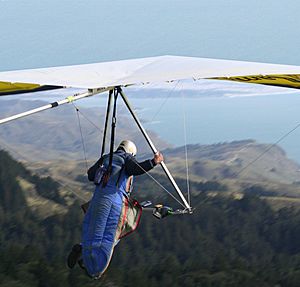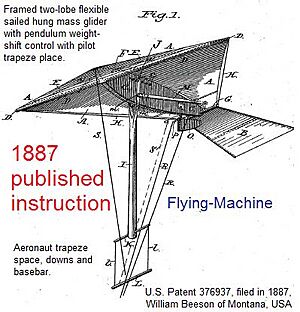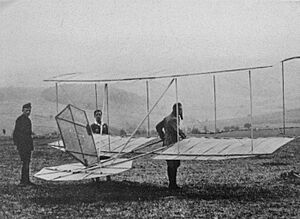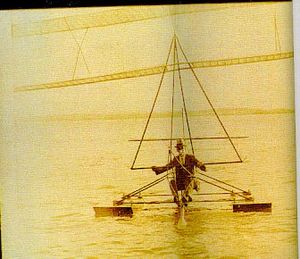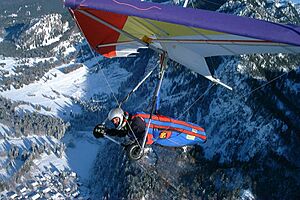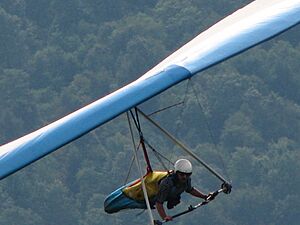History of hang gliding facts for kids
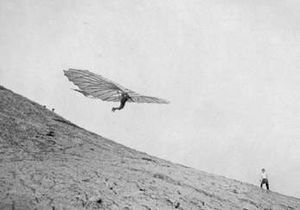
Hang gliding is an exciting air sport where you fly a special aircraft that you launch by foot. A modern hang glider usually has a frame made of strong, light metal or special composite materials. It has a fabric wing. The pilot wears a harness and hangs from the frame. You control the glider by shifting your body weight. This moves the glider in the direction you want to go.
Contents
How Hang Gliding Began
Early hang gliders were not always safe. Their builders didn't fully understand how flight worked. The first recorded controlled flights were made by a German engineer named Otto Lilienthal. He published his research in 1889, which helped many later designers. The aircraft Lilienthal used is now called a hang glider. More research on hang gliders happened in the 1920s in Europe, Australia, and the US. Designers tried out different wing shapes and a control system where the pilot shifted their weight.
In 1957, the American space agency NASA started testing a new wing. It was called the Rogallo wing. They thought about using it to help the Gemini space capsules land safely. This wing was simple to design and build. It also flew slowly, which was good for landing. Hang glider fans noticed this. In 1963, John Wallace Dickenson adapted Rogallo's flexible wing for fun flying. This started a new era for hang gliding.
Early Flight Adventures
George Cayley built a glider in 1853 that flew with a pilot. He launched it from a slope. From the 1880s, people made big steps in understanding how things fly and how to build them. This led to the first truly useful gliders. Early flyers and inventors often shared their ideas. This helped build a long series of small improvements.
In the 1880s, many flight pioneers appeared around the world. They all worked on glider designs with different levels of success. Some important ones were Otto Lilienthal in Germany, Lawrence Hargrave in Australia, Percy Pilcher in the United Kingdom, and John Joseph Montgomery in the US.
Otto Lilienthal copied some of his friends' work and added a lot to it. He published all his research in 1889. He also made many gliders. By 1891, he could regularly make controlled flights of 25 meters (82 feet) or more. He even made some flights where he soared. He wrote down everything he did very carefully. This helped later designers a lot. Because of this, he is one of the most famous and important early flight pioneers. His type of aircraft is now known as a hang glider. By 1896, he had made about 2,000 flights of 250 meters (820 feet) with his designs. Sadly, he crashed from about 15 meters (49 feet) high and broke his spine.
Percy Pilcher became very interested in flying. He built a glider called The Bat and flew it for the first time in 1895. Later that year, Pilcher met Otto Lilienthal, who was the top expert in gliding. Their talks led Pilcher to build two more hang gliders: The Beetle and The Gull. In 1897, Pilcher built a third hang glider called The Hawk. He used ideas from his mentor, Otto Lilienthal. With The Hawk, he broke the world distance record by flying 250 meters (820 feet).
Gliding at Wasserkuppe
Hang gliders became less important when the Wright brothers invented wing warping in 1902. Later, the French developed aileron control. After World War I ended in 1918, the Treaty of Versailles stopped Germany from flying engine-powered planes. So, in the 1920s and 1930s, Germans focused on designing and flying better gliders. They learned how to use natural air currents to fly farther and faster. These activities at Wasserkuppe helped gliding become popular again. Many gliders flown in 1920 were hang gliders. They were controlled only by the pilot shifting their weight.
The first Wasserkuppe glider competition was held in 1920. From 1924, the Rhön-Rossitten Gesellschaft organized them. Over the next ten years, the contest grew very popular. Up to 70 glider clubs from Europe sent their best gliders and pilots. They competed for prizes for how long, how high, and how far they could fly. The most wanted prize was from President Paul von Hindenburg. As many as 60,000 people watched these events from the mountain slopes. Almost every European aircraft engineer at the time tested their planes there.
The Flexible Wing is Born
In 1904, Jan Lavezzari showed off a flexible-wing hang glider in France. In 1908, a glider with a triangle control frame was shown in Germany. The pilot hung behind it. These ideas were not widely known, so they didn't affect later flexible wing designs.
In 1948, engineer Francis Rogallo invented a wing that could inflate itself. He patented it in 1951 as the Flexible Wing, also known as the flexwing or Rogallo wing. Rogallo first suggested his flexible wing to the Langley Research Center in the 1940s. He thought it would be a simple and cheap way to fly for fun. But the idea was not picked up as a project.

On October 4, 1957, the Russian satellite Sputnik launched. This worried the United States and started the 'space race'. It also led to the creation of NASA. Rogallo was in a good position to help. With his help at the wind tunnels, NASA began testing his flexible wing. They called it the Parawing. They wanted to see if it could be a recovery system for the project Gemini space capsules. Rogallo designed his flexible wing so astronauts could open it like a parachute. They could then glide their capsule to a specific landing spot. Rogallo's team worked with American aircraft companies. They saw potential for gliders and other new types of aircraft. This involved making the front edges stronger with air or metal tubes. By 1961, NASA had already tested an experimental STOL aircraft called the Ryan XV-8. By March 1962, they tested a weight-shift glider called Paresev.
However, round parachutes were chosen for the Gemini spacecraft instead of the Rogallo wing. In 1965, funding for flexible wing research stopped.
Flexible-Wing Hang Gliders
The Rogallo wing was simple to build and fly. It could fly slowly and land gently. These features were noticed by hang glider and ultralight glider fans. News about the Fleep and Paresev tests made independent builders interested. People like Barry Palmer and John Dickenson separately worked on different frames and control systems. They wanted to adapt the Rogallo wing to be flown as a hang glider.
In August 1961, American engineer Barry Palmer built and flew the first foot-launched Rogallo-wing hang glider. This happened near Latrobe, California. Palmer used aluminum tubes and no wires to build it. He was worried about the tubes bending during assembly. Most flights were done with just parallel bars. These bars split his weight between his underarms and hands.
Palmer's last foot-launched hang glider flew in the summer of 1962. It had a seat like a ski-lift. This seat was attached to the main beam with a special joint. This allowed for weight-shift control. From 1961 to 1963, Barry Palmer made many flights using this idea. His longest flight was up to 180 meters (590 feet) long. He reached altitudes up to 24 meters (79 feet). His glider could travel 4.5 units forward for every 1 unit it dropped.
Palmer's wing was heavy compared to today's gliders. It was also not very easy to carry. Palmer had a good job in aerospace and flew for fun. He didn't try to make or sell the flexible-wing hang glider. He shared all his ideas with anyone who was interested.
In April 1963, Mike Burns first flew the Skiplane. It was a flexible wing glider on floats. In September 1963, Australian inventor John Dickenson wanted to build a water ski wing. It would be released high up and glide to a safe landing. He saw a Rogallo wing parachute in a magazine. Dickenson then designed his ski kite, called the Ski Wing. Dickenson made a frame that included a triangle control bar. He used wires to spread the load to the Rogallo wing. The pilot sat on a swinging seat. Dickenson's Ski Wing was stable and easy to control. This was different from the flat manned kites used in water ski shows at the time.
The Ski Wing was first flown in public in September 1963. This was at the Grafton Jacaranda Festival in Grafton, Australia. Rod Fuller piloted it while being towed by a motorboat. The Ski Wing was light and easy to carry. So Dickenson decided to apply for a patent. But he didn't have enough money, so his temporary patent later expired. By 1972, Australian builders Bill Bennett and Bill Moyes improved Dickenson's water ski kite. They turned it into a foot-launched hang glider.
In 2012, John Dickenson received the Gold Medal from the Fédération Aéronautique Internationale. This was for "the invention of the modern hang glider."
Stiff-Wing Hang Gliders
Several stiff-wing hang gliders have flown since Otto Lilienthal's first flights in the 1890s. However, the first two high-performing modern ones were the Mitchell Wing and the Icarus.
In 1908, a gliding club in Germany had a pilot hang behind a triangle control frame. This was for weight-shift control. Hang gliders with similar control were also built by Percy Pilcher, Augustus Herring, and others.
In the early 1940s, Don Mitchell, an engineer, started working on flying wing glider designs. World War II stopped his research until 1974. That's when hang gliding became very popular. People were trying new designs and breaking records worldwide. Mitchell's flying wing idea came back. Dr. Howard Long asked Don Mitchell to make a better 'flying wing' hang glider. The result was the foot-launched Mitchell Wing. When the Mitchell Wing B-10 flew in the 1977 US Nationals, the hang gliding world was amazed. The Mitchell Wing then set and held every world record in its class. In 1980, George Worthington soared to 5,182 meters (17,000 feet) high. He then glided 169 kilometers (105 miles). This set two new records for stiff-wing gliders.
In the 1950s, Volmer Jensen designed the VJ-11 and VJ-23. These were biplane stiff-wing hang gliders.
In 1971, Jack Lambie, a teacher from California, designed the popular Hang Loose. It was a biplane hang glider in the style of Chanute. Lambie organized the first modern hang glider meeting. It was called the Otto Meet. It took place in September 1972 on the hills of Balboa.
In 1971 and 1972, the Icarus I and Icarus II were built. These were stiff biplane flying wing designs by Taras Kiceniuk, Jr. The Icarus V was a single-wing version of the earlier Icarus gliders.
Growing Popularity
NASA's research, reports, and photos of the flexible wing were made public. Soon, the Rogallo wing became an easy-to-build, cheap, foot-launchable glider. Barry Palmer talked with Richard Miller. In 1964, Miller developed the Bamboo Butterfly. Then came Tara Kiceniuk's Batso. Dave Kilbourne published plans for a Rogallo wing Kilbo Kite hang glider in the early 1970s. Jim Foreman made Bat-Glider plans and sold them for $5 worldwide. Later, Taras Kiceniuk, Tom Dickinson, and others made a similar hang glider called Batso and sold its plans. Plans for these hang gliders appeared in magazines in the mid-1960s.
Eventually, news of John Dickenson's success spread. More portable flexible wing gliders were built. In 1969, manufacturers like Bill Bennett (Delta Wing) and Bill Moyes (Moyes Gliders) started selling his improved water ski hang gliders. This greatly increased the flexible wing's popularity. It began to grow worldwide as a full sport.
The exciting nature of foot-launched hang gliding appealed to the free-spirited culture of the early 1970s in America. It was seen more as a way to express freedom than just an air sport. Its popularity grew even more with special international magazines. These included Low & Slow (1971), Hang Glider Weekly and Ground Skimmer (1972), and Glider Rider (1975). Major international magazines like Popular Mechanics, Popular Science, and Life also promoted hang gliding in 1971. The Sky Riders hang gliding movie came out in 1976 and had a big impact. The British SkyWings magazine has been published monthly since 1975. Cross Country, the first truly international hang gliding magazine, started in 1988.
Free hang gliding took longer to become popular in Australia. There, hang gliding was part of water skiing. Dickenson's Ski Wing competed in the water skiing association's kite-flying section. The first recorded foot-launched flight in Australia happened in 1972. The Australian Self Soaring Association was formed by foot-launched pilots in 1974. The first foot-launched Australian Championships were held in 1976.
In the early 1970s, Moyes flew from Mt. Kilimanjaro. Caril Ridley's flights in India made headlines. In 1973, German TV made a 30-minute film about Mike Harker's world record hang glider flight from Mt. Zugspitze in Germany. This film helped hang gliding grow in Europe. Harker also made other hang gliding films in the mid-1970s. These were shown on TV in 16 countries.
By the early 1970s, many stiff-wing gliders were made, but they didn't sell well. Meanwhile, dozens of flexible-wing hang glider companies started up worldwide. The mid-1970s saw big improvements in hang glider design. Manufacturers released new and better models quickly. From the simple gliders of the early 1970s, gliders became much more efficient. Their sails became tighter, and battens (stiffeners) became common. Gliders also became safer. In the late 1970s, pre-shaped aluminum battens were common. The Manta Fledgling IIB won the 1979 US Nationals. This made people more interested in double-surface wings and pilot-controlled surfaces. The "Fledge" showed big improvements in how far it could glide and how it could maneuver. In 1980, the Comet became very popular. It made the free-floating crossbar and double-surface sail common. This design is now standard.
It's hard to say exactly how these developments happened. But the flexible-wing hang glider became popular because of the publicized Paresev and Fleep ideas. Then came John Dickenson's design. And then, the strong efforts of people like Bill Bennett, Bill Moyes, and others. Plus, thousands of people wanted to glide. This started what is now a big industry. It's interesting that Dickenson never made money from his invention. And Francis Rogallo never claimed rights to his patent. This allowed his flexible wing airfoil to be used for free.
Hang Gliding Milestones
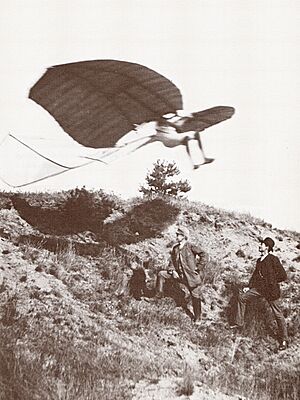
- 1804: Sir George Cayley built gliders. He understood lift and drag and designed tails and rudders.
- 1883–86: John Joseph Montgomery built gliders in the US. He studied how wings lift.
- 1887: William Beeson patented a flexible-wing glider. The pilot hung below it and shifted weight.
- 1891: First controlled flights by Otto Lilienthal in Germany. His gliders were foot-launched and controlled by weight-shift.
- 1891–96: First soaring flights by Otto Lilienthal in Germany.
- 1904, Feb 15: Jan Lavezzari flew a double-sail hang glider in France.
- 1905: LIFE magazine showed a photo of an early glider.
- 1905: Aeronaut Daniel Maloney flew a balloon-launched glider to a specific landing spot.
- 1908: A gliding club in Germany flew a hang glider with a pilot hanging behind a triangle control frame.
- 1920: Soaring became an organized sport at Wasserkuppe, Germany. This happened because the World War I treaty banned powered aircraft in Germany.
- 1921: Dr. Wolfgang Klemperer broke the Wright Brothers' soaring record with a 13-minute flight in Germany.
- 1921: Gottlob Espenlaub showed a triangle control frame for his hang glider in Germany.
- 1923: The Platz glider was made. It couldn't be foot-launched by the pilot alone.
- 1928: Austrian Robert Kronfeld showed that gliders could use thermal lift to gain height.
- 1929: Aero towing became popular. People learned about different types of lift.
- 1929: George A. Spratt showed how to use a triangular control frame for weight-shift control.
- 1933: Wave lift was discovered in Germany.
- 1948: Francis Rogallo invented the flexible wing (Rogallo wing).
- 1954: Igor Bensen continued using the hung-pilot-behind triangle control frame for kite gliders.
- 1956: Engineer Paul MacCready invented the MacCready Speed Ring. Glider pilots use it to find the best flight speed.
- 1957, October: Francis Rogallo gave his flexible wing patent to the US government and NASA. This led to the Parawing for space capsules.
- 1960: Paresev (Paraglider Research Vehicle) was an experimental space glider using the Rogallo wing. Its tests in 1962 inspired hobbyists to build flexible-wing hang gliders.
- 1960: 13-year-old Tony Prentice built a flexible-wing hang glider with a tether control.
- 1961: Fleep, a powered flexible wing aircraft, began design and production.
- 1961–62: First documented foot-launch with a Rogallo flexible-wing hang glider by Barry Hill Palmer in California, US. He was inspired by a photo of NASA's Fleep.
- 1961: Jim Hobson experimented with the Rogallo wing. He built a full-size glider and flew it in 1962.
- 1961: Engineer Thomas Purcell built a 4.9-meter (16-foot) wide Rogallo wing glider.
- 1962: Ryan Aeronautical Company showed pictures of the Fleep flexible wing aircraft.
- 1962: Mike Burns and Dick Swinbourne designed the Skiplane kite-glider based on the Rogallo wing. It used weight-shift control and floats.
- 1963: John W. Dickenson in Australia made the Ski Wing. This was a very important hang glider model with a control frame and weight-shift control.
- 1963, September: First flight of the Ski Wing, towed by a motorboat in Australia.
- 1963: First release and return to water of a Ski Wing by John Dickenson.
- 1960s: Tony Prentice designed and flew several non-Rogallo hang gliders in England.
- 1966: Mike Burns and Dick Swinbourne began selling Dickenson's Mark V model.
- 1966: Richard Miller built early flexible-wing hang gliders called Batso and Bamboo Butterfly. Their photos and plans were published.
- 1966: Irvin Industries started selling a commercial version of the Rogallo Wing for sport parachuting.
- 1967, March: Bill Moyes and Bill Bennett learned to fly the Mark V hang glider from Mike Burns and John Dickenson.
- 1967: First ski-launch of a flexible-wing hang glider without towing by Bill Moyes in Australia.
- 1969: Bill Moyes made a 32-minute flight by being towed into the wind and then releasing to soar.
- 1969: Tony Prentice made the first flexible-wing hang glider foot-launch in the United Kingdom.
- 1971: Dave Kilbourne foot-launched and soared for 1 hour at Mission Peak, California, US. This was likely the first foot-launch of a flexible wing without skis.
- 1971: Alfio Caronti launched the first flexible wing in Italy.
- 1972: Rick Poynter and Murray Sargeson introduced hang gliding to New Zealand. The New Zealand Hang Gliding Association was formed.
- 1973: Rick Poynter started Pacific Sails in Auckland, New Zealand, making hang gliders.
- 1973: The first film about hang gliding, "The New Freedom," was made.
- 1974: Caril Ridley made high-altitude flights in India. This got worldwide attention.
- 1975: First unofficial World Championship in Kössen, Austria. 300 pilots competed.
- 1975: First movie appearance in the Australian film, The Man from Hong Kong.
- 1976: Official FAI World Championships in Hang gliding in Kössen, Austria. Terry DeLore from New Zealand became the first World Champion.
- 1976: Rudy Kishazy performed the first loop and series of loops in France.
- 1977: Jerry Katz was the first to soar over 161 kilometers (100 miles) in California.
- 1979: Manta Fledgling IIB's success led to interest in double-surface wings.
- 1980: East Germany banned hang gliding. This was to stop people from escaping to the West.
- 1983: Gérard Thévenot introduced aerotowing (being towed by another aircraft).
- 1983: Larry Tudor broke the 200-mile barrier on a flexible-wing glider.
- 1990: Larry Tudor broke the 300-mile barrier on a flexible-wing glider.
- 1992: The Exxtacy stiff-wing hang glider was designed by Felix Ruehle.
- 1999: The ATOS stiff-wing hang glider was designed by Felix Ruehle.
- 2001: Manfred Ruhmer broke the 400-mile barrier on a flexible-wing glider.
- 2012: John W. Dickenson received the Gold Air Medal for inventing the "modern hang glider."
How Gliders Changed Over Time
Here's how flexible-wing hang gliders improved over the years:
- 1971–75: First Generation – The sport grew worldwide. Companies started making hang gliders.
- 1974–76: Second Generation – Gliders had a bigger nose angle and new parts called deflexors.
- 1977–79: Third Generation – More deflexors were added.
- 1978–80: Fourth Generation – The main beam (keel) and tip rods were covered.
- 1978: The Atlas (La Mouette) came out. The pilot flew lying down. It had safety features still used today.
- 1980–97: Fifth Generation – Pre-shaped battens and a floating crossbar were introduced. The crossbar was covered inside the double surface. Hang glider performance quickly improved. The Manta Fledge IIB (1979) and the UP "Comet" (1980) were very successful "double surface" hang gliders. Most gliders for the next ten years were improved versions of the Comet. Bob Trampenau introduced the VG (variable geometry) system. This was copied on most other hang gliders.
- 1997–present: Sixth Generation – Topless gliders appeared (without a kingpost). Strong carbon fiber crossbars allowed the kingpost on top of the wing to be removed. This reduced drag and made gliders perform even better.
See also
- Aviation history
- Early flying machines
- Glider aircraft
- John W. Dickenson
- Hang gliding
- Paragliding
- Powered hang glider
- Rogallo wing
- Timeline of aviation


